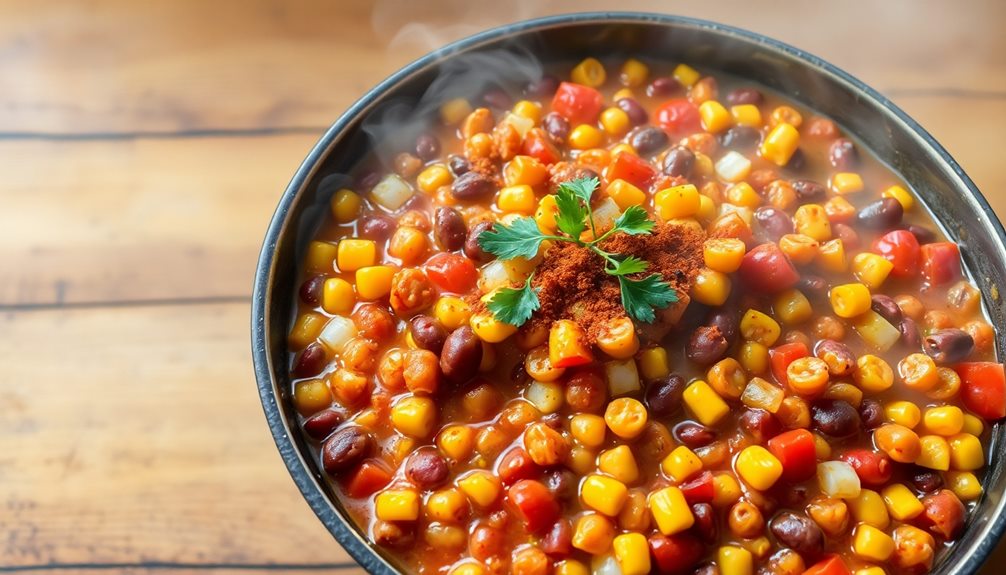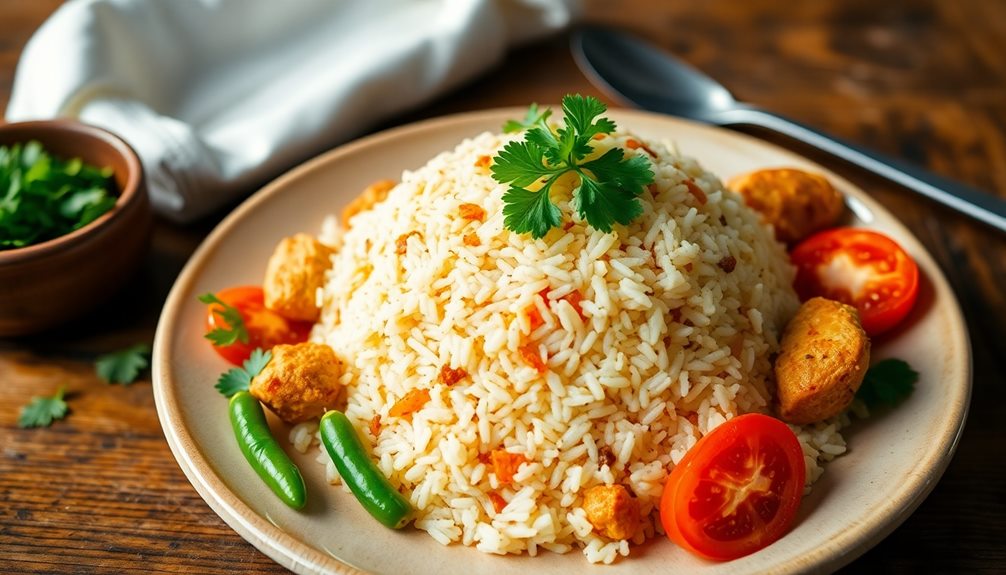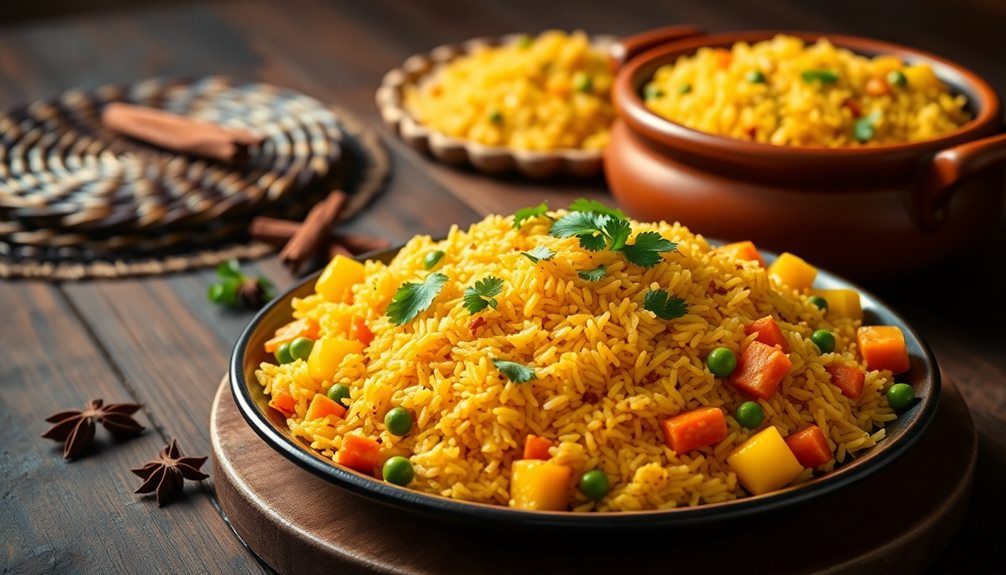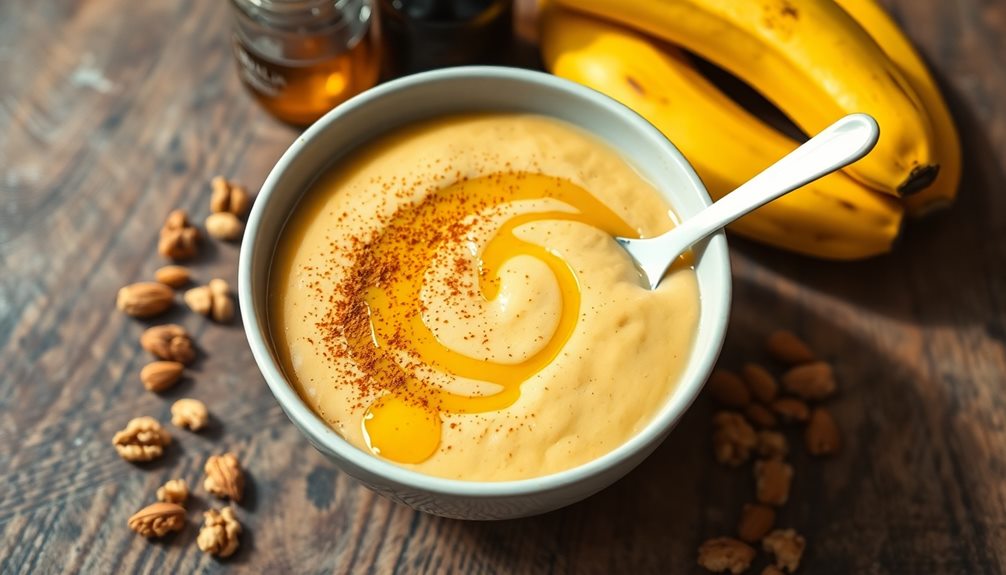Githeri is a scrumptious Kenyan dish combining hearty beans and sweet maize. You'll start by soaking the beans overnight, which softens them and reduces cooking time. Then, you'll rinse the beans and add them to the pot with the maize, simmering until the veggies are tender. Next, you'll stir in savory spices like salt and cumin, blending the flavors together. Finally, you'll serve the piping hot githeri garnished with refreshing cilantro. This vibrant, nourishing meal showcases the rich culinary heritage of Kenya – and if you keep reading, you'll discover even more delightful details about this beloved dish.
Key Takeaways
- Githeri is a traditional Kenyan dish made with a boiled mixture of maize and beans, reflecting the country's agricultural heritage.
- The dish is simmered with onions, garlic, and tomatoes to create a nourishing and flavorful meal.
- Soaking the beans overnight and rinsing them thoroughly are essential steps for achieving the perfect texture and flavor.
- Seasoning the githeri with spices like salt, cumin, and chili powder enhances the natural sweetness of the corn.
- Serving the hot dish garnished with fresh cilantro adds a refreshing contrast and brings out the vibrant flavors of Kenyan cuisine.
History

Githeri, a traditional Kenyan dish, has a rich history deeply rooted in the country's agricultural heritage.
For centuries, Kenyan farmers have grown maize and beans, the two key ingredients in githeri. These crops were staples in the diets of many Kenyan communities, providing essential nutrients and sustaining the population.
Over time, githeri evolved as a way to combine these readily available ingredients into a nourishing and satisfying meal. The dish's name is derived from the Kikuyu word "githeri," which refers to the boiled mixture of maize and beans.
Githeri was often prepared over a fire, with the ingredients simmered together until they formed a thick, flavorful stew.
Today, githeri remains an integral part of Kenyan cuisine, enjoyed by people across the country.
It continues to be a beloved comfort food, a symbol of the nation's culinary heritage, and a reflection of the resilience and resourcefulness of the Kenyan people.
Cooking Steps
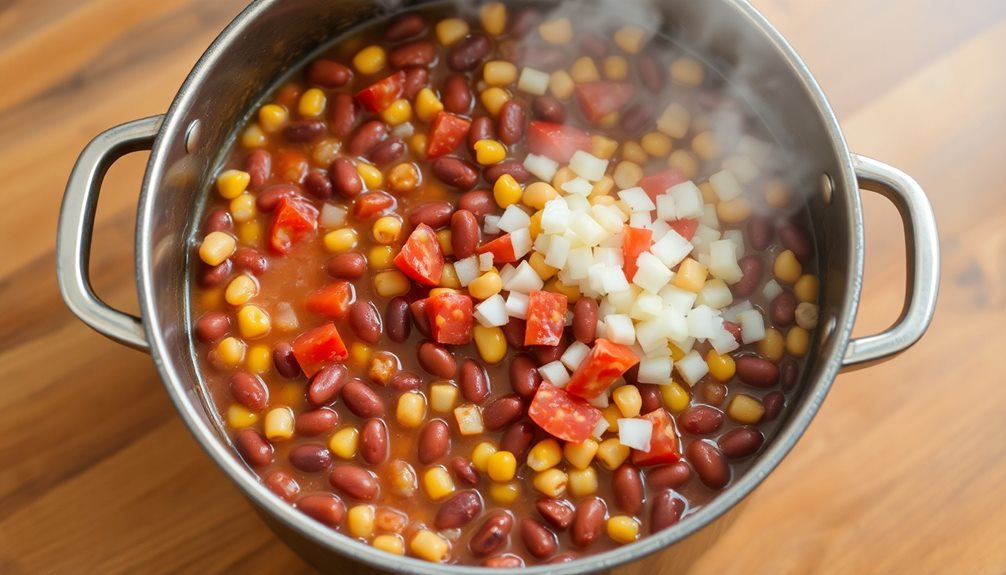
To begin, start by rinsing the githeri in a colander under cold running water. This will remove any dirt or debris.
Next, in a large pot, sauté the onions, garlic, and tomatoes until fragrant and softened. Carefully add the rinsed githeri, along with the water or broth, to the pot. Bring the mixture to a boil, then reduce the heat and let it simmer for about 30 minutes, or until the beans and corn are tender.
As the githeri simmers, make sure to stir it occasionally to prevent sticking or burning. You can add more water or broth if the mixture seems too thick.
Once the githeri is cooked through, season it with salt, pepper, and any other desired spices, such as cumin or paprika. Serve the githeri hot, garnished with fresh cilantro or chopped tomatoes, if desired. Enjoy this hearty, flavorful Kenyan dish!
Step 1. Soak Beans Overnight Beforehand
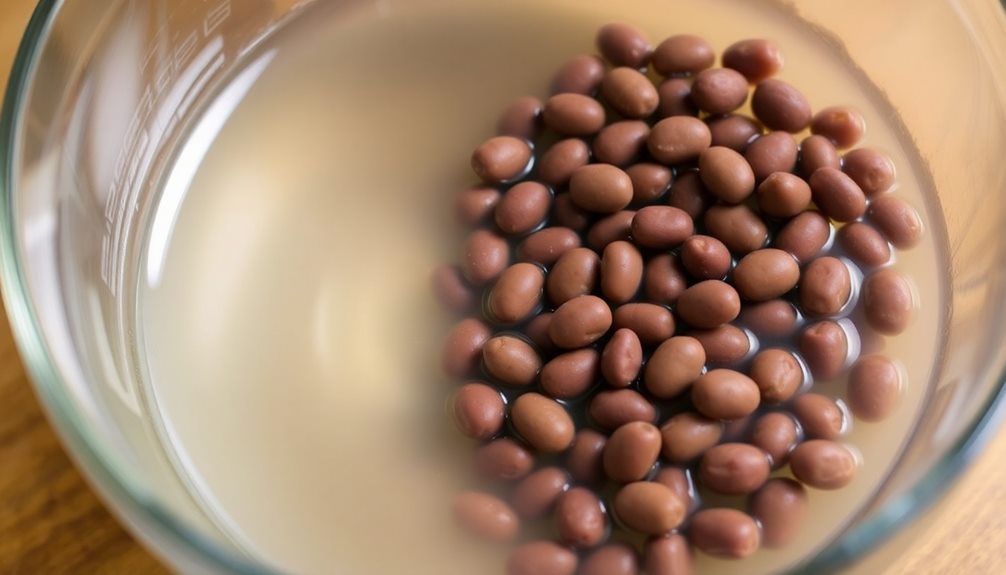
Before starting the cooking process, it's important to soak the beans overnight. This step helps soften the beans and reduces their cooking time. Simply place the beans in a large bowl and cover them with water. Let them soak for at least 8 hours or overnight. This allows the beans to absorb moisture, making them more tender and easier to cook.
Once the beans have soaked, drain and rinse them thoroughly. This removes any debris or dirt that may have accumulated during the soaking process.
Now you're ready to begin the next step in the Githeri recipe – cooking the beans and maize together. The soaked beans will cook more quickly, so you can expect a faster and more efficient cooking time.
Step 2. Drain and Rinse Soaked Beans

Once the beans have soaked overnight, you'll want to drain and rinse them thoroughly. This step is crucial to remove any impurities and help the beans cook more evenly.
Grab a colander and place it in the sink. Carefully pour the soaked beans into the colander, letting the water drain out. Then, turn on the tap and give the beans a good rinse, using your hands to gently stir them around.
You want to make sure all the water from the soaking process is washed away. Once the beans are rinsed, give the colander a few shakes to help remove any excess moisture.
Now your beans are ready for the next step in the githeri recipe! This simple yet important step sets you up for delicious, properly cooked beans that will be the perfect foundation for your Kenyan-inspired dish.
Step 3. Add Maize and Simmer
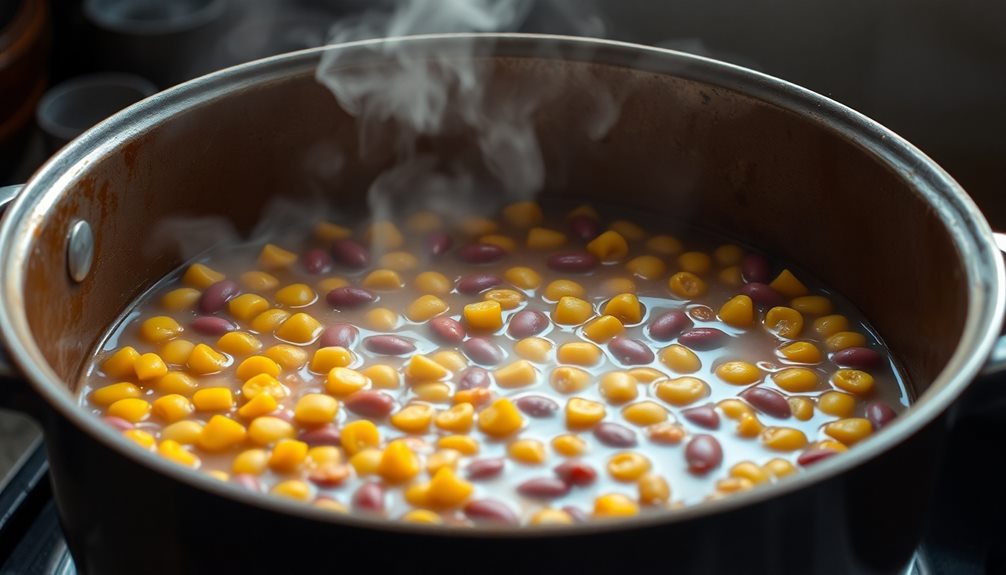
With your rinsed beans ready, add the maize to the pot. Stir them together, making sure the maize is fully submerged in the liquid.
Now, turn the heat down to medium-low and let the mixture simmer. As it simmers, the flavors will meld, and the maize will soften, creating a wonderfully hearty texture.
Keep an eye on the pot, stirring occasionally to prevent sticking or burning. The simmering process should take around 20-25 minutes, or until the maize is tender and the beans are cooked through.
Be patient – this step is crucial for developing the rich, comforting flavors of the githeri.
Once the maize and beans are perfectly cooked, you're ready to move on to the next step. Get ready to enjoy the delicious aroma and satisfying taste of this classic Kenyan dish!
Step 4. Add Seasonings

Now, add the salt, cumin, and any other desired seasonings to the simmering githeri. A sprinkle of salt and a teaspoon of cumin will really make the flavors pop.
You can also try a dash of paprika or a pinch of chili powder if you want a bit of heat. Stir everything together and let the flavors meld for a few minutes. The salt enhances the natural sweetness of the corn, while the cumin adds an earthy, aromatic note.
Feel free to experiment with your favorite spices – maybe a little garlic powder or dried thyme? Just be sure not to overpower the delicate flavors of the beans and maize.
Taste the githeri and adjust the seasonings as needed. You want a well-balanced dish that's bursting with flavor in every bite.
Once you've got the seasoning just right, it's time to serve up this nutritious and satisfying Kenyan classic.
Step 5. Serve Hot, Garnished With Cilantro

Serve the githeri hot, garnishing each portion with a sprinkle of fresh cilantro. The bright, vibrant green of the cilantro leaves will add a pop of color and a delightful herbal aroma to the dish.
The crisp, fragrant cilantro pairs beautifully with the hearty beans and tender corn, creating a mouthwatering contrast of flavors and textures. Be generous with the cilantro, as it really brings the whole dish together.
The cool, slightly citrusy notes of the herb will refresh your palate and balance the richness of the beans. Serve the githeri immediately, while it's still steaming hot, to fully enjoy the interplay of temperatures and flavors.
The warmth of the dish, combined with the fresh, cool cilantro, will create a truly satisfying and comforting meal. Enjoy every bite of this flavorful Kenyan classic! The rich blend of aromatic spices and tender, well-cooked rice ensures that every element of this dish resonates with tradition and heartwarming flavor. Whether you’re preparing it for a family gathering or a quiet dinner at home, this Kenyan pilau recipe overview will guide you in recreating an authentic culinary experience. Let the enticing aromas transport you straight to the vibrant streets of Kenya with every spoonful!
Final Thoughts
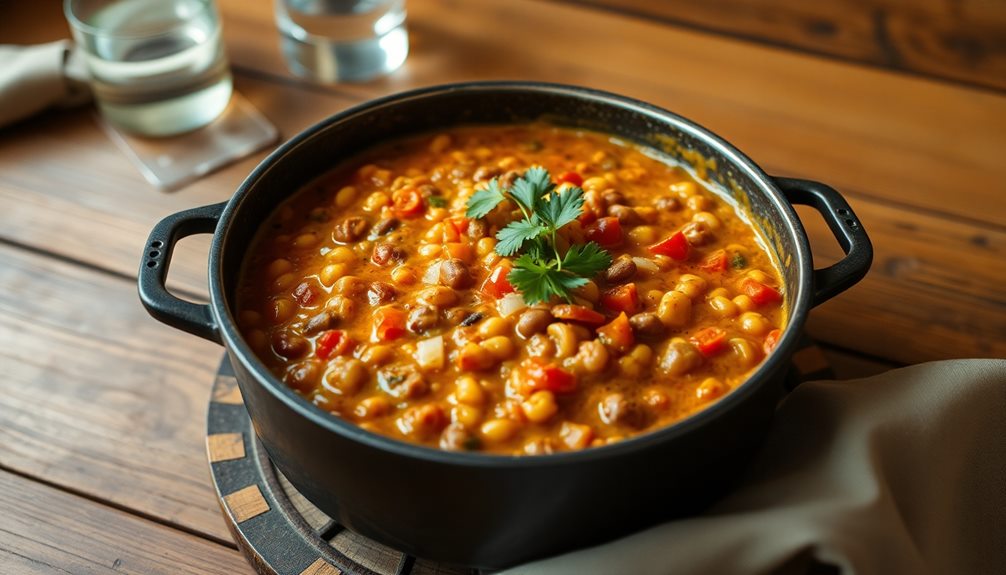
Preparing this simple githeri recipe is a delightful way to enjoy a hearty and nutritious meal. With its vibrant colors and satisfying blend of flavors, it's a dish that's sure to impress.
As you savor the soft, tender beans and the sweet, toasted corn, you'll be transported to the heart of Kenyan cuisine.
Now that you've mastered the art of making githeri, don't be afraid to experiment. Try adding different vegetables or spices to suit your taste buds. Perhaps a sprinkle of cumin or a dash of chili powder could liven things up.
And remember, the beauty of this dish lies in its versatility – it can be enjoyed as a main course, a side dish, or even a wholesome snack.
Whether you're cooking for your family or entertaining guests, this githeri recipe is sure to delight. Embrace the rich cultural heritage and the comforting flavors of this Kenyan classic. Bon appétit!
Frequently Asked Questions
What Is the Origin of the Name "Githeri"?
The name "githeri" comes from the Kikuyu language, a major ethnic group in Kenya. It's a traditional dish that's been part of their culture for generations, reflecting the rich culinary heritage of the region.
How Can I Make Githeri More Filling and Protein-Rich?
To make githeri more filling and protein-rich, you can add more beans, lentils, or even ground meat. You could also incorporate nutritious vegetables like kale or spinach to boost the nutrient content.
Is Githeri Suitable for Vegetarians or Vegans?
Yes, githeri is suitable for vegetarians and vegans. It's a versatile dish that's packed with plant-based protein from the beans and carbohydrates from the maize. You can easily make it vegan by omitting any dairy or animal products.
Can I Freeze Leftover Githeri for Later Use?
You can definitely freeze leftover githeri for later use. Just let it cool completely, then transfer it to an airtight container or freezer bag. It'll keep for up to 3 months in the freezer.
What Are Some Common Variations or Adaptations of the Traditional Githeri Recipe?
You can try variations like adding vegetables like kale, spinach, or carrots. You can also use different types of beans or even add meat like beef or chicken. Get creative and make it your own!
